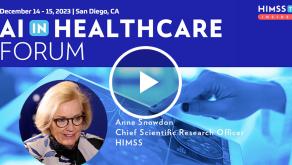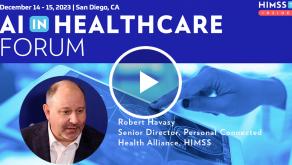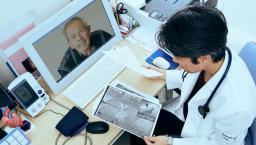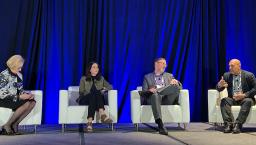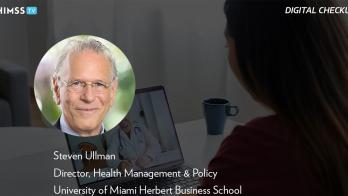How remote patient monitoring is moving into the mainstream

Dr. Waqaas Al-Siddiq, chairman, CEO and founder of Biotricity
Photo: Biotricity
The COVID-19 pandemic most certainly has driven telehealth into the mainstream of healthcare. And one area of telehealth that has seen particularly big gains in the past two years is remote patient monitoring.
RPM benefits healthcare during the pandemic by helping with hospitals already packed to the gills, enabling patients to be monitored and treated at home. Further, RPM has reduced the amount of time patients must spend in situations where the COVID-19 virus can be transmitted.
Beyond the pandemic, RPM can keep patients out of the high-cost setting of a hospital and at home, where, further, the patients will be happier, thus improving the patient experience while reducing those costs.
It's clear RPM will be playing a bigger role in healthcare than it ever has before. On this note, Healthcare IT News spoke with Dr. Waqaas Al-Siddiq, chairman, CEO and founder of Biotricity, a medical diagnostic and healthcare technology company that offers both physician- and consumer-facing RPM devices.
He explained how RPM can help manage chronic conditions and ease the burden on hospitals, described the future of wearables and shared some lessons learned during the pandemic.
Q. What impact has the pandemic had on chronic conditions? How can RPM help?
A. On the chronic side, we saw a worsening of conditions after the pandemic began. This has led to what providers are now calling "health debt," an accumulated impact of changes in health behaviors as a result of the pandemic.
Many physicians have seen chronic conditions deteriorate. This is for two reasons – one is that chronic patients concerned about COVID, as they are at higher risk, are avoiding and delaying care. An estimated 41% of adults in the U.S. had delayed or avoided medical care by June 2020, and those with chronic conditions were much more likely to stay away from the hospital or clinic.
For chronic patients, their concerns are amplified. They are at greater risk for complications from COVID-19 and are trying to be safe. But when you have a chronic condition, you need to maintain contact with providers to stay on track. And the added stress of living in a pandemic is enough to worsen a chronic condition, which has been reported. Patients need more care, not less.
The other is that many physicians didn't have access to the right remote patient monitoring tools to help prevent this and provide to patients who wouldn't visit a clinic in person. There are long-term consequences to delaying care, and RPM can absolutely help mitigate this impact.
We've seen this in programs where tools like pulse oximeters, spirometers, and connected thermometers and stethoscopes were used to monitor patients discharged from the hospital after COVID-19. But there are many conditions that lack devices that can provide an adequate level of care in the home.
Diabetics have glucometers, but people with COPD, sleep apnea and atrial fibrillation, among others, need devices that can sufficiently track them. Right now, physicians will only see pieces of these patients' conditions. If there is a reduction of in-person visits, ultimately, this will not be enough for many high-risk patients.
With RPM, we are really at the early stages of what can be done for patients with chronic disease. We can advance RPM by looking at diagnostic devices that currently exist for each condition, find which sensors can be integrated into wireless devices, and create clinically relevant, continuous solutions.
This is just the beginning, and we have an opportunity to innovate with both clinicians and patients open and ready to adopt new solutions.
Q. How has remote patient monitoring been easing the burden on the COVID-clogged healthcare system?
A. Telemedicine is at the forefront of discussion around COVID, and it was a great tool to deal with episodic care during the pandemic, reducing the number of patients frequenting providers. We've heard a lot about the huge increase of telehealth video usage, which rose by almost 50% in the first quarter of 2020.
But telehealth alone isn't able to provide an adequate level of care that many patients need – especially chronic patients. They need to be tracked very closely and frequently to keep their condition from worsening. If a patient is skipping appointments and check-ins, their condition could easily reach a point where they will suddenly need to visit the hospital or ER.
Being able to see what's happening while they're at home, away from the clinic, prevents this. Real-time remote patient monitoring is what made a difference here. With real-time monitoring, you're able to watch blood glucose levels, heart rhythm changes and vital signs live.
If you're alerted to a problem, you're able to decide the appropriate course of action before the patient rushes into the emergency room or reaches a point to where this is needed. You're better able to manage treatment and adherence. An important level of communication is maintained.
One of the biggest expenses in healthcare is chronic conditions. Individuals suffering from chronic issues frequent hospitals and clinics while also having higher risk of COVID complications. Remote patient monitoring has been a big boost in collecting data from chronic patients remotely, without the need for them to come into the care setting as often, thereby easing the burden on the system while reducing patient risk.
Research has shown that remote patient monitoring significantly reduces hospital readmissions and emergency room visits. This is critical when staff is already overwhelmed, and it helps reduce the risk of exposure for them, as well.
RPM was used to discharge COVID patients faster, once stabilized, by using devices like pulse oximeters to monitor them remotely and promote home-based self-isolation. As far as success with these programs, we've seen that satisfaction rates for providers and patients are very high.
Studies on their effectiveness also revealed a large impact on improving recovery and preventing hospital admissions. This has helped providers become more comfortable with using RPM in other areas of their clinical practice.
The FDA quickly recognized how critical this would be when they issued a remote patient monitoring enforcement policy in 2020. Hospitalization rates are currently at the highest they've been, so the need is still there.
Q. What do you see for the future of wearables, and how will the devices impact healthcare at large?
A. I see the future of wearables as medical or clinically relevant devices. Up until now, wearables have been more lifestyle-oriented with limited applications for healthcare and disease management.
In the future, I believe we will have more accurate and clinically relevant wearables that collect clinical data off users, which can then be used for insights to deliver better care. Combining this level of data with AI for deeper analysis will lead to not only better care but also faster and more preventative care.
We're also seeing a larger trend, somewhat influenced by wearables, with healthcare becoming a more consumer-oriented experience. When tech meets healthcare, inevitably, an emphasis on user experience, design and function via features will become fundamental to development.
This is opening up new ways to put individuals and patients first as we begin to look closely at how things like design and usability can impact outcomes. For providers, improving the patient experience will help increase efficiency. It's also furthering the adoption of value-based care by realigning incentives to outcomes.
Ultimately, this leads to better data collection, and this data will help advance precision medicine. Continuous data combined with AI leveraging analytics will increase predictive capabilities and allow for more timely intervention and management of concerns.
The clinical applications of this are far-ranging and will make preventative care the norm. With multiple data streams from vitals and biomarkers, we can closely monitor the progression of disease and begin to pick apart its complexity – with assistance from both clinicians and artificial intelligence.
The additional context from wearables will enable providers to make more informed decisions about a patient's care plan or treatment and pave the way for wearables for chronic conditions.
Wearables will become increasingly important for chronic patients. Chronic conditions account for 75 cents of every $1 spent in healthcare. This issue is that most of these patients have no tools to manage their condition and instead frequent the doctor's office.
If you look at diabetes and hypertension, both these patient groups have tools to manage their condition through glucometers and blood pressure cuffs. But other chronic conditions lack long-term, clinically relevant devices for management. Cardiac patients, COPD patients, epileptic patients and others have no devices like this to manage their conditions.
Chronic diseases have the added complexity of requiring long-term data to see trends in a patient's condition or measure the effectiveness of a program and/or prescription. Today, if there is no tool, this is being done manually.
I foresee the future of wearables as filling this gap: bridging the chasm between clinical diagnostic devices and short-term fitness wearables by creating solutions that take clinical sensors, connect them, [and] put them into a form factor for long-term data collection, with improved usability and AI-assisted analysis.
Q. What lessons have you learned about remote patient monitoring during the pandemic to date?
A. Usability and adoption have been huge issues in healthcare technology. They always say, necessity is the mother of invention. We saw this play out acutely during the pandemic. I was surprised by how many individuals, regardless of age or technological literacy, went out of their comfort zone to figure out how to use remote tools, telemedicine, remote monitoring devices, etc.
In my mind, it cemented the idea that individuals will adopt, if you can solve a big enough problem or show them how important something is to their personal wellbeing.
Adoption of telemedicine was fast, both from the clinical and patient sides. There were so many different providers with variations in their workflows, and yet, patients and clinicians were willing to invest the time to figure out how to utilize them.
In many cases, a patient would end up using two or three different telemedicine solutions depending on the doc or specialist they were receiving care from. We saw this translate into new products that we offered, expecting way more support requests but seeing much less.
The same held true when it came to remote patient monitoring. Patients were willing and able to experiment with new devices and learn how to utilize remote patient monitoring to support their care. There was an uptake in patient utilization when it came to a variety of remote patient monitoring devices such as pulse oximeters, digital thermometers, otoscopes, personal ECG and others.
Utilization was not just using the device but collecting data and delivering that information to their care providers. This required individuals to connect devices, upload and sync data, follow remote instructions, and perform other tasks that normally individuals were not able or willing to do.
The key takeaway is that this willingness of users to experiment creates an opportunity for RPM companies to innovate and deploy fast. Individuals will invest the time to use and learn new solutions and are not turned off by challenges or imperfect workflows.
In fact, the biggest lesson or takeaway from the pandemic is to build and deploy fast while keeping a tight connection to users in order to perfect your solution. But deploy first and perfect in the field.
Before the pandemic, this approach was more mainstream in technology companies, whereas in healthcare, this approach was nonexistent. This is a reminder that if you solve a big enough problem, people will, in fact, invest the time to learn.
Q. What will it take for RPM to become truly mainstream like telehealth has become because of the pandemic and loosening regulations?
A. In my opinion, RPM is lacking two things to drive more mainstream adoption: continuous data collection and usability. RPM devices need to be really simple to use and they need to collect long-term data.
The biggest market for RPM is chronic patients, who are synonymous with intermittent asymptomatic issues. Adoption comes when users see a benefit, requiring feedback as to why something is beneficial. This requires long-term continuous data, giving users better insights into what is working.
If we focus on providing RPM solutions that can collect long-term data, individuals will have this feedback and insight, facilitating adoption. To put it simply, if you go to the gym and your goal is weight loss or muscle development and you see that you are developing muscle, you will continue to go. We need to enable that same concept with RPM.
The best way to achieve that is to develop continuous RPM solutions. Then you open up the door to link this data and things like disease progression, behavior change and biomarkers on a more granular level.
These connections will be uniquely valuable for providers looking to understand patient progress on both a population level and an individual level. And for individuals themselves, RPM will help us understand what feedback works, and why, and as a result, we'll make better tools. The use of continuous RPM will accelerate this.
People are also interested in learning more about their health, so adoption of wearables is growing, and this is all creating a lot of rich patient-generated health data that can be used to promote positive feedback loops.
People are more engaged and empowered to manage their health when they discuss self-generated health data, like data from wearables, with a provider. The benefits are already there.
Longitudinal data will uncover more effective feedback loops, and coupled with usability, this will promote improved adherence and adoption where we are effectively targeting the behaviors that lead to the desired outcome – a healthier diet, activity, blood glucose levels, etc.
RPM and wearables can provide new insights on this, and I anticipate they will become a part of standard care delivery as a result, ranging from preventative applications to managing more complex conditions. Once providers and individuals truly grasp the value of this data, there's no turning back.
Twitter: @SiwickiHealthIT
Email the writer: bsiwicki@himss.org
Healthcare IT News is a HIMSS Media publication.





